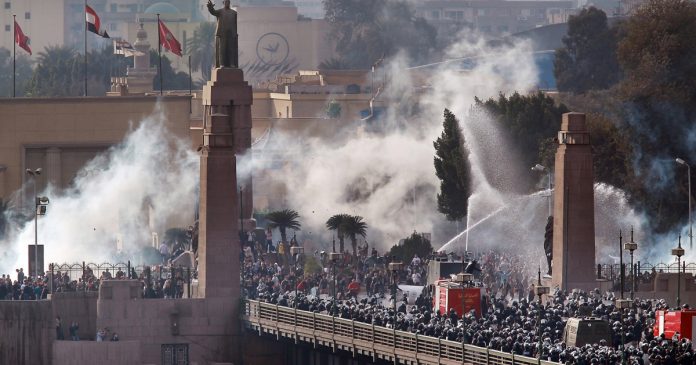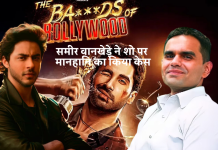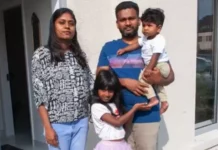[ad_1]
We stood side by side on the steps of the Iowa State Capitol, our bodies moving in unison as I led hundreds of people in Al-Maghrib prayer – the sunset prayer. We were gathered to protest against President Donald Trump’s Muslim travel ban.
As we prayed, I caught the flash of blue and white lights out of the corner of my eye, as several police cars arrived. I felt my body tense instinctively; I was immediately taken back to the memory of my first protest on the streets of Cairo many years earlier. In 2007, I was 21 years old, and instead of hundreds, we were just seven young people protesting against then-President Hosni Mubarak. Our chants were largely ignored by the bustle of the city around us; no one noticed except for the police who swarmed in and started chasing us. Eventually, one officer tackled me to the ground and started kicking me with his steel-toed boots.
It was just my first taste of the pain Egyptian police officers inflict. Over the next few years, their deadly force would touch my life directly, time and time again. That night in Des Moines though, I was shocked to find the police were not there to hurt us but to protect us and our right to fundamental freedoms, as we marched through the streets of the city. It was the first time I had protested against a president and got to sleep in my own bed the same night.
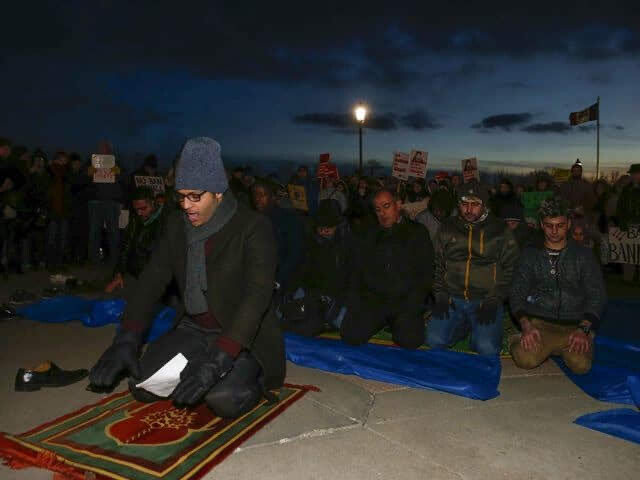 Esam leads Muslim prayer on the steps of the Iowa State Capitol as people gather to protest against President Donald Trump’s Muslim travel ban in 2017 [Photo courtesy of Esam Boraey]
Esam leads Muslim prayer on the steps of the Iowa State Capitol as people gather to protest against President Donald Trump’s Muslim travel ban in 2017 [Photo courtesy of Esam Boraey]From the square to the courtroom
My journey to the United States was not a simple or easy one. In 2007, I got my first job and with it came my first paycheque. I excitedly returned home to my mom and offered to buy her something with my newly earned money. To my surprise, she told me the best gift would not be one purchased in a store, but instead, to get married and start a family – she already had the perfect bride in mind.
That night, I told my friends about my new wedding plans and was met with instant resistance. They told me I was crazy to make plans to bring children into the chaotic world in which we were living. At that time, Egypt was facing unprecedented unemployment, our healthcare system was in tatters and the public education system had fallen apart. My friends told me bringing new life into our country was either ignorant or selfish and I would be wise to avoid it. I found myself at a crossroads – be alone for the rest of my life, never marry and start a family, or do something to change my country for the better.
I spent the next four years building a career in the international human rights sector studying the development of democracy in the Arab world and building contacts within burgeoning grassroots movements as part of a broader strategy to advise decision-makers in the MENA region and abroad.
On January 25, 2011, I was in the streets of Cairo once again, but this time I was protesting not just with a handful of others, as I had before, but with tens of thousands of my countrymen and women. Our chants of “Yuskut Hosni Mubarak, Yuskut, Yuskut Hosni Mubarak”, meaning “Down with Hosni Mubarak”, echoed through Tahrir Square. The days that followed were some of the most inspiring and moving moments of my life but also some of the most painful.
As we were crossing Qasr Nile Bridge on January 28, I was among the thousands of protesters who suddenly found themselves blockaded from both sides as the police and military moved in on either side of the bridge. We found ourselves with two options: Jump into the Nile River below or proceed directly towards the armed forces in front of us. I grabbed the hand of the man standing next to me and we started running together. As we neared the end of the bridge, I suddenly felt his grip slip from my own. When I turned back I saw the police had shot him. I knelt beside him and moved to try to carry him off the bridge, but he quickly stopped me and in his final words urged me to keep moving forward, whispering: “I lost my life for this cause, make sure it wasn’t for nothing and promise me you’ll keep fighting.” By the end of the 18 days we spent in Tahrir Square, Mubarak was finally overthrown, but the moment was bittersweet as we remembered the hundreds of fellow protesters whose lives had been lost.
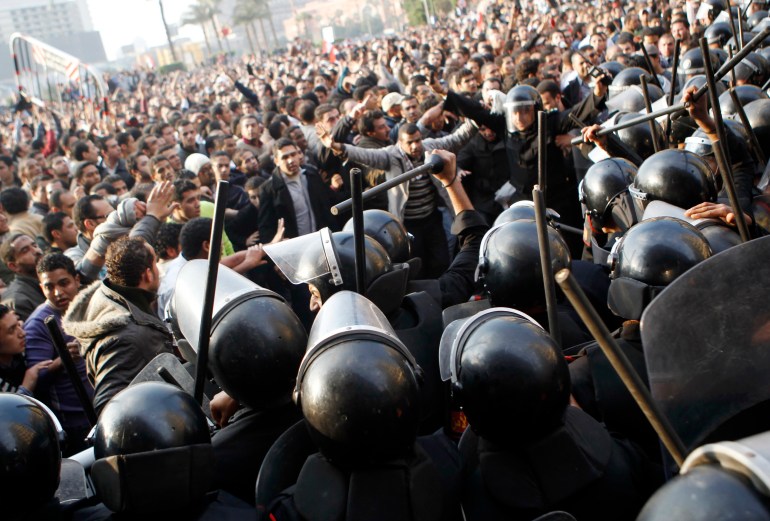 Anti-government protesters demonstrate near riot police in Tahrir Square in Cairo on January 25, 2011 [Amr Abdallah/Reuters]
Anti-government protesters demonstrate near riot police in Tahrir Square in Cairo on January 25, 2011 [Amr Abdallah/Reuters]
This moment in our history was spontaneous but it was not an accident. For decades, Mubarak’s regime ignored signs of failure within the country and refused to adopt strategies to improve the state of affairs. Instead, the president focused on securing his power and passing it down to his youngest son after his departure. He directed the country’s resources to security services where they were used to maintain his authority. The situation in Egypt in the years leading up to the revolution made an uprising from the people inevitable. It was never led by one individual or one organisation but was rather a mass mobilisation of the people.
In the weeks before January 25, young Egyptians used social media to spread the word about the protests. The hope was to get a maximum of 10,000 people in the streets for a single day to try and advocate for reform, mainly against police brutality. However, the events that unfolded on January 25 and the violent response from the regime inspired and encouraged more Egyptians in cities across the country to take to the streets in support.
After Mubarak was overthrown, support for democratic freedoms and fundamental human rights was at an all-time high. I joined efforts to co-found Al-Dostour Party, the Constitution Party, which was aimed at advocating for the revolution’s principles of justice, freedom and human dignity. I was also working for an international organisation on the ground to support a peaceful transition of power. I even started preparing to stand in the parliamentary election myself.
But by the end of the year, I found myself inside a criminal courtroom and eventually in exile. In December 2011, my office at the International Republican Institute was raided and I was arrested along with several of my colleagues. Our eventual trial came to be known as the “NGO Trial”, 43 people were charged, including at least 15 Americans. I was charged and convicted of working for a human rights organisation and taking money from a foreign government in the form of my salary and sentenced to two years in prison. But before I was taken to prison, I was able to flee the country and ended up in Washington, DC.
The parallels
After moving to the US, I quickly immersed myself in American politics and soon found parallels between the struggle for justice in Egypt and the US. I joined the Bernie Sanders presidential campaign in 2015 and experienced another grassroots movement where an outsider was challenging the existing status quo. Much like the activists of the Arab Spring movement, Bernie built his campaign by focusing on the young and disenfranchised. As an outsider, he was initially ignored by much of the corporate media and in turn relied on social media to engage and connect with his supporters. He was never able to secure the Democratic Party nomination but nonetheless, his policies and platforms have taken root in the party and helped shift it dramatically to the left. As part of his team, I witnessed how his policies and popularity grew over the last few years.
Like Bernie, the youth movements for democracy in the Middle East were unable to achieve their ultimate goals, but they clearly changed the face of the region forever. The Arab Spring inspired political candidates and community activists worldwide. Grassroots movements like Black Lives Matter have many principles and techniques in common with their counterparts in the Middle East and North Africa. Both movements were sparked spontaneously in numerous communities in reaction to police brutality. There have even been instances where some BLM activists, like the Dream Defenders, have taken visits to the region, specifically Palestine to learn and strategise together.
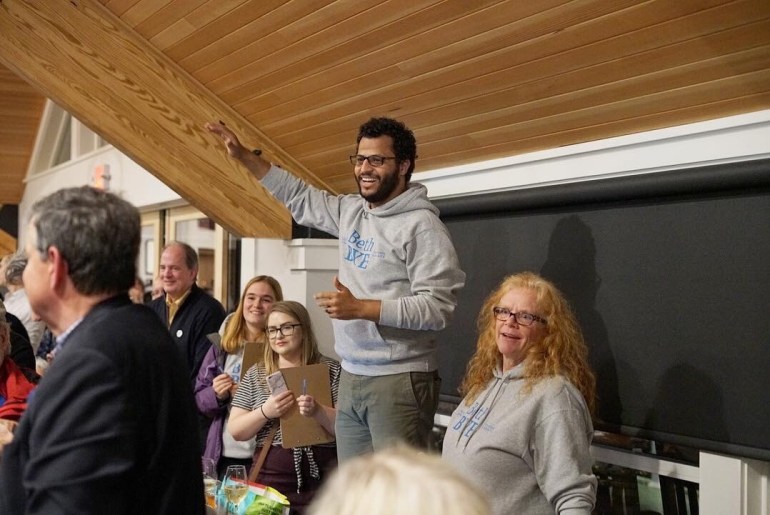 Esam celebrates as campaign manager for Connecticut state senator Beth Bye at a 2018 midterm election victory party [Photo courtesy of Esam Boraey]
Esam celebrates as campaign manager for Connecticut state senator Beth Bye at a 2018 midterm election victory party [Photo courtesy of Esam Boraey]
American political leaders on the left and the right have often expressed support for the Arab Spring. In theory, it closely aligns with the principles of American values and the pursuit of freedom and democracy. However, their follow-through with tangible actions has often fallen short. As global leaders, they are obligated to formulate pragmatic foreign policy based on their own nation’s best interests, which tends to mean they continue to back dictators in the region despite their abysmal human rights records. I once had a discussion with a high-ranking government official closely involved in the decision-making process in Washington and he told me it is easier for the US to deal with one dictator abroad than a group of elected officials because negotiating with one strongman is always easier, especially with the lack of accountability an authoritarian regime has compared with the public accountability secured with democratically elected administrations.
History teaches us nothing is perfect. On March 7, 1965, activists and protesters crossed the Edmund Pettus Bridge in Selma, Alabama, to protest for the right to vote. While they were brutally attacked by the police, this march ended in a significant victory for the African American community in the voting rights battle. It was a parallel situation in Egypt as we crossed Qasr El-Nile in 2011. Decades later, African Americans are still fighting for their rights and struggling against discrimination and racism. Egyptian and other Middle Eastern activists need to learn that it takes time and persistence to win a war.
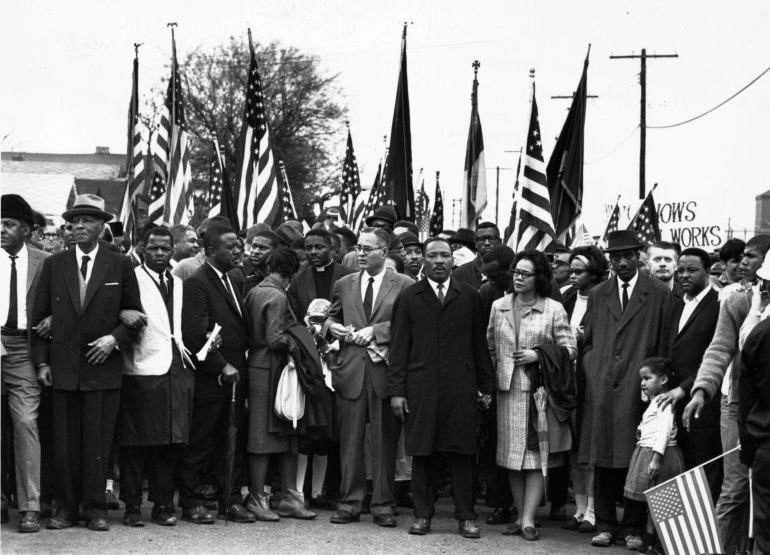 Martin Luther King, Jr and his wife Coretta Scott King stand with marchers in Selma, Alabama in 1965 as they protest for the right to vote [William Lovelace/Express/Getty Images]
Martin Luther King, Jr and his wife Coretta Scott King stand with marchers in Selma, Alabama in 1965 as they protest for the right to vote [William Lovelace/Express/Getty Images]Still hope
Ten years after the Arab Spring, the situation now is not promising, but I am still optimistic.
With Tunisia as a relative exception, no revolution was able to take hold long-term. Civil wars have created humanitarian crises in Yemen, Libya, and Syria leading to a wave of refugees.
Many other countries, like Egypt, witnessed the return of the old regimes or even worse. Most of the region experienced a decline in the fundamental freedoms gained after the Arab Spring. For example, in the immediate years following the revolution in Egypt, freedom of expression was at an all-time high. However, when current President Abdel Fattah el-Sisi came to power in 2014, his regime imprisoned dozens of journalists – the International Press Institute estimates as of 2020, there are some 60 independent journalists held behind bars. Additionally, human rights organisations in the country have suffered from a government crackdown on their right to organise and operate.
Many of the activists and organisers involved in the movement have been killed, imprisoned, or exiled like me. The majority in the region chose security and stability over democracy. But I still have hope.
The exiled members of the movement are building our experience, knowledge, and education abroad, and are ready when the opportunity arises to serve our home countries. Like many others in the diaspora, my love for Egypt is boundless and I will never stop believing in a brighter future for Om El-Donya, Egypt, my homeland.
[ad_2]
Source link

